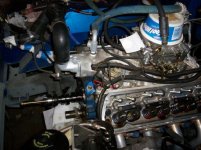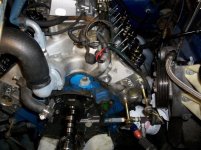Good solid compressoin ratio goes along way toward volumetric efficincy. with alum heads you can typically get away with higher compression ratios on 91 octane and not have problems with detonation. (within reason) Also you can have highish compression ratio with stock cam.
Thermal efficincy. Real simply, you get more pop per drop (of fuel)
Volumetric efficincy is simply moving the air through the engine and has more to do with runner shape, valve timing, etc.
More compression is better, so long as you have the fuel (octane) so support it.
This gets into a whole new chapter, cylinder pressures. Increasing compression ratio is a very obvious way to increase cylinder pressure. But valve timing has a lot to do with it as well. The huge compression ratio numbers in high HP engines is also backed by big lumpy cams that don't close the valves in time to build optimal cylinder pressures, especially at low engine speeds. But they make up for that by making good volumetric efficincy at higher RPMs. Velocity, momentium, will let the engine keep making power at higher RPMs then a stock cam would.
An RV style cam plays with the valve timing a little to bolster the cylinder pressures notibly at low RPMs. Add in a little extra valve lift to promote better flow and you have the classic RV cam that wakes up a stock engine.
If you go a step further look at diesel cams. They are there to maximize cylinder pressures so you have enough compression to light off the diesel fuel. If you were to take a 14:1 compression engine you are talking a low compression diesel or a high compression gas engine. The difference is how the cam is profiled. With a gas engine lots of overlap, long drawn out valve timing to keep the cylinder pressures in check. But a diesel will need the intake to close very near BDC just so there will be enough cylinder pressure to light off the fuel. All in the valve timing.
The last 351 I built turning into an 11:1 aluminum headed beast. I was aiming for high 9's but didn't correctly factor in the short deck height of the '70 block. I already had the RV style cam. That chased my cranking compression into the 200+ PSI range. It was sensitive to timing, a little too much and it rattled. On a hot day and the water temp went past 200° and it would like to rattle. On a hot restart it would start as a diesel, my rattle start. I am sure the only way it lived as good as it did was all the little tricks I put into the engine as I built it. Chamfered all the sharp edges in the head, especially around the plugs. Ceramic coated the piston face. (accidently) ran a super tight quench height. Not a way you should plan to build an engine, but it happen to work out and run real good.
Compression is great for making an engine run good, just not too much.













